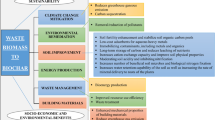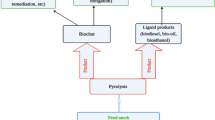Abstract
Global threats including climate change, land degradation, environmental contamination, and water shortages lead to economic, social and environmental damage. These need to be addressed to overcome the major disaster occurring now and in near future. Sustainable Biochar (BC) from biomass and wastes can be an environmentally-friendly option for carbon sequestration, soil fertility improvement, pollution remediation and agricultural by-product/waste recycling. Pyrolysis of lignocellulosic biomass to bio fuels and other value-added products including biochar has attracted considerable attention since the mid-1970s due to petroleum price spikes, climate change and increasing energy demand [1]. Fast and slow pyrolyses are promising routes to renewable liquid fuels, biochars and chemicals. Fast pyrolysis is a promising route to recover renewable liquid fuels. Fast pyrolysis employs short residence time (<3 s) at 400-5000C in absence of oxygen to generate bio-oil or pyrolytic oil, bio-char and gas [1, 2].
Access this chapter
Tax calculation will be finalised at checkout
Purchases are for personal use only
Similar content being viewed by others
REFERENCES
Mohan, D., Pittman, Jr., C.U. and Steele, P.H.: Pyrolysis of Wood/Biomass for Bio-oil: A Critical Review. Energy & Fuels, 20, 848–889 (2006)
Pittman, Jr., C.U., Mohan, D., Eseyin, A., Li, Q., Ingram, L., Hassan, E.-B.M., Mitchell, B., Guo, H. and Steele, P.H.: Characterization of Bio-oils Produced from Fast Pyrolysis of Corn Stalks in an Auger Reactor. Energy Fuels, 26, 3816–3825 (2012)
Mohan, D., Sarswat, A., Ok, Y.S. and Pittman, C.U.: Organic and Inorganic Contaminants Removal from Water with Biochar, a Renewable, Low Cost and Sustainable Adsorbent – A Critical Review, Bioresource Technology, Accepted (2014)
Ahmad, M., Rajapaksha, A.U., Lim, J.E., Zhang, M., Bolan, N., Mohan, D., Vithanage, M., Lee, S.S. and Ok, Y.S.: Biochar as a sorbent for contaminant management in soil and water: A review. Chemosphere, 160, 191–202 (2014)
Lehmann, J.: Bio-energy in the black. J. Frontiers in Ecology and the Environment, 5, 381–387 (2007)
Lehmann, J.: A handful of carbon. Nature, 447, 143–144 (2007)
Lehmann, J., Gaunt, J. and Rondon, M.: Bio-char sequestration in terrestrial ecosystems – A review. Mitigation and Adaptation Strategies for Global Change, 11, 403–427 (2006)
Liang, B., Lehmann, J., Solomon, D., Kinyangi, J., Grossman, J., O’Neill, B., Skjemstad, J.O., Thies, J., Luizão, F.J., Petersen, J. and Neves, E.G.: Black Carbon Increases Cation Exchange Capacity in Soils. Soil Science Society of America Journal, 70, 1719–1730 (2006)
Mohan, D., Kumar, S. and Srivastava, A.: Fluoride Removal from Ground Water using Magnetic and Nonmagnetic Corn Stover Biochars. Ecological Engineering, In Press (2014)
Mohan, D., Sharma, R., Singh, V.K., Steele, P. and Pittman, Jr., C.U.: Fluoride Removal from Water using Biochar, a Green Waste, Low-Cost Adsorbent: Equilibrium Uptake and Sorption Dynamics Modeling. Industrial and Engineering Chemistry Research, 51, 900–914 (2012)
Mohan, D., Rajput, S., Singh, V.K., Steele, P.H. and Pittman, Jr., C.U.: Modeling and evaluation of chromium remediation from water using low cost bio-char, a green adsorbent. Journal of Hazardous Materials, 188, 319–333 (2011)
Mohan, D., Pittman, Jr., C.U., Bricka, M., Smith, F., Yancey, B., Mohammad, J., Steele, P.H., Alexandre-Franco, M.F., Gómez-Serrano, V. and Gong, H.: Sorption of arsenic, cadmium, and lead by chars produced from fast pyrolysis of wood and bark during bio-oil production. Journal of Colloid and Interface Science, 310, 57–73 (2007)
Author information
Authors and Affiliations
Corresponding author
Editor information
Editors and Affiliations
Rights and permissions
Copyright information
© 2016 Capital Publishing Company
About this paper
Cite this paper
Mohan, D., Kumar, A., Pittman, C.U. (2016). Sustainable Biochar - A Tool for Climate Change Mitigation, Soil Management and Water and Wastewater Treatment. In: Raju, N. (eds) Geostatistical and Geospatial Approaches for the Characterization of Natural Resources in the Environment. Springer, Cham. https://doi.org/10.1007/978-3-319-18663-4_146
Download citation
DOI: https://doi.org/10.1007/978-3-319-18663-4_146
Publisher Name: Springer, Cham
Print ISBN: 978-3-319-18662-7
Online ISBN: 978-3-319-18663-4
eBook Packages: Earth and Environmental ScienceEarth and Environmental Science (R0)




